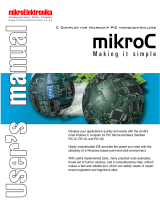
CAN-SPI Additional Board
MikroElektronika
CAN-SPI Additional Board
The CAN protocol is compliant with ISO standard and is primarily used in serial communication. It was originally intended for
applications in automotive industry, but these days it is commonly used in other industries where a high noise resistance and high
level of reliability at transferring data is required.
CAN network consists of several nodes cabled together (L and H lines). There is one CAN controller in each of these nodes used to
adjust standard digital signals to voltages present in the network. The CAN-SPI board features a transciever MCP2551 that provides
necessary signal adjustments and enables these signals to be sent/received at a rate of up 1 Mb/s. In addition, this circuit serves
as a protection against high voltages that might appear in the network (EMI, ESD, noise caused by induction, etc.). The CAN-SPI
board also features the MCP2515 circuit used as a CAN controller that exchanges data with microcontrollers using a standard Serial
Peripheral Interface (SPI).
Figure 1: CAN-SPI additional board Figure 2: CAN-SPI board connected to a development system
Figure 3: CAN-SPI additional board connection schematic
There are two connectors provided on the board.
A 2x5 connector is used for connection with a
development system the board is connected to,
whereas a screw terminal with contacts marked H
and L enables connection with the network. Since
the board uses SPI interface for communication
with microcontrollers, it may also be used with
microcontrollers which are not supplied with the
built-in CAN module.
DIP switch SW1 is used to select pins on
the microcontroller port to be used for SPI
communication (MISO, MOSI and SCK lines).
Downloaded from Arrow.com.Downloaded from Arrow.com.


